Discover the Diverse Wildlife of Lake Manyara’s Unique Ecosystem




Introduction
Lake Manyara National Park in Tanzania is a stunning natural gem known for its unique and diverse ecosystem, which supports a rich variety of wildlife and plant life. Situated along the Great Rift Valley escarpment, Lake Manyara National Park spans approximately 330 square kilometers, with the lake itself covering a substantial portion of the park. The Lake Manyara ecosystem is composed of alkaline waters, lush forests, open savannas, and towering escarpments—all of which create an environment that sustains a wide array of species. For anyone interested in exploring diverse African wildlife within a compact yet vibrant setting, Lake Manyara offers an unforgettable experience.
The Unique Ecosystem of Lake Manyara
The ecosystem of Lake Manyara is notable for its variety of habitats in a relatively small area. This diverse environment includes:
- Alkaline Lake Manyara: The shallow, alkaline lake occupies much of the park’s surface, attracting countless species of waterbirds, including vast flocks of flamingos that create a pink blanket over the lake at certain times of the year. The lake’s mineral-rich waters provide nutrients essential to bird populations and other aquatic life.
- Groundwater Forest: Near the park’s entrance lies a dense, groundwater forest, where water from underground springs sustains lush vegetation. This forest is home to blue monkeys, baboons, and bushbucks, as well as numerous bird species. It also provides a unique contrast to the open landscapes of the savanna.
- Open Savannah and Grasslands: Beyond the forest, visitors find expansive grasslands that support large herbivores such as zebras, wildebeests, and buffalo. These areas are also where you might spot Lake Manyara’s famous tree-climbing lions.
- Acacia Woodlands: The woodlands around the lake are a prime habitat for elephants, giraffes, and various antelope species. The acacia trees not only provide food for these animals but also offer shade and shelter, adding to the diversity of habitats within the park.
- Hot Springs (Maji Moto): Toward the southern end of the park, the Maji Moto hot springs create an unusual, geothermal environment. These springs add to the park’s biodiversity and are a fascinating geological feature of the Manyara ecosystem.
Diverse Wildlife Supported by Lake Manyara’s Ecosystem
The Lake Manyara ecosystem supports a wide range of wildlife, making the park an ideal destination for animal lovers and photographers alike.
1. Birdlife and Aquatic Species
Lake Manyara National Park is a paradise for birdwatchers. The lake’s alkaline waters attract over 400 bird species, including:
- Flamingos: Perhaps the park’s most iconic bird, flamingos are drawn to the lake’s mineral-rich waters, feeding on algae and crustaceans. When present in large numbers, they create a striking pink display along the lake’s surface.
- Pelicans, Cormorants, and Storks: These waterbirds are also commonly seen on the lake, adding to the rich birdlife that thrives in the ecosystem.
- Raptors and Forest Birds: In the forested areas, visitors can find fish eagles, crowned eagles, and various hornbills. The dense foliage of the groundwater forest provides a perfect habitat for these species.
This diversity of birdlife makes Lake Manyara one of the best birdwatching spots in Africa, especially during the wet season when migratory birds flock to the lake.
2. Mammals and Herbivores
The park’s varied landscapes allow for a thriving population of large mammals, each adapted to different parts of the ecosystem:
- Elephants: Known for its large elephant population, Lake Manyara National Park provides ample space for these magnificent animals to roam. Elephants here often wander through acacia woodlands and grasslands, where they feed on vegetation and seek out water sources.
- Tree-Climbing Lions: One of the park’s most unique attractions is its tree-climbing lions, which are rare in Africa. These lions often rest in acacia trees to escape heat and insects on the ground. Spotting them in trees is a rare and thrilling sight for visitors.
- Buffalo, Giraffes, and Zebras: The open plains and woodlands host a variety of herbivores, including buffalo, giraffes, and zebras. These animals are commonly seen grazing in herds, especially during the dry season when they gather near the lake’s edge for water.
- Hippos: Near the lake’s shoreline, visitors might spot hippos lounging in the water. The lake provides a safe habitat for these massive creatures, allowing them to stay cool and protect themselves from predators.
3. Primates and Smaller Mammals
Lake Manyara’s groundwater forest is especially rich in primate life:
- Baboons: One of the most visible animals in the park, baboons live in large social groups and are often seen near the park entrance, where the forest is densest.
- Blue Monkeys and Vervet Monkeys: These smaller primates also inhabit the forested areas, adding an element of playful activity to the dense greenery.
- Bushbucks and Dik-Diks: These small antelope species can be seen darting through the forest, often blending in with the undergrowth.
Seasonal Changes in the Lake Manyara Ecosystem
The ecosystem of Lake Manyara experiences seasonal shifts that affect both the landscapes and the wildlife. Each season brings its own unique aspects to the park:
- Wet Season (November to May): During the wet season, the lake fills up, attracting larger numbers of flamingos and migratory birds. The park’s vegetation becomes lush, and food sources for herbivores are plentiful, drawing in large herds of animals. This period is ideal for birdwatching, as the increased water level supports a greater variety of aquatic species.
- Dry Season (June to October): As water sources diminish during the dry season, animals gather near the lake and other water points, making wildlife spotting easier. The dry season also offers clear skies, providing excellent visibility for panoramic views of the park’s unique ecosystem. While the forest remains green thanks to underground springs, the surrounding savanna takes on a golden hue, enhancing the park’s natural beauty.
Conservation Efforts and Sustainability in Lake Manyara’s Ecosystem
Lake Manyara’s diverse ecosystem is fragile and requires dedicated conservation efforts to ensure its longevity. Various initiatives have been implemented to protect this unique environment:
- Anti-Poaching Efforts: Protecting the park’s wildlife from poaching is a top priority. Anti-poaching units work within the park to monitor and safeguard animals, particularly elephants, which are targeted for their ivory.
- Eco-Tourism: Lake Manyara National Park emphasizes eco-friendly tourism. Lodges around the park often follow sustainable practices, from using solar power to sourcing locally made furnishings. Visitors are encouraged to respect the park’s guidelines, supporting the preservation of its natural environment.
- Community Involvement: The park works with local communities to promote sustainable resource use, providing them with income opportunities through tourism. Community-led initiatives, such as cultural tours and locally guided safaris, benefit both the residents and the conservation efforts.
How to Experience the Lake Manyara Ecosystem
For those looking to fully immerse themselves in the Lake Manyara ecosystem, there are several ways to explore and enjoy this unique environment:
- Guided Safari Tours: Experienced guides provide in-depth knowledge of the park’s flora and fauna, ensuring visitors understand the ecological importance of each area. Safari tours often include stops at key viewing points, allowing for a close look at the lake, forest, and open plains.
- Birdwatching Expeditions: With such a rich array of bird species, a birdwatching tour is a must for avian enthusiasts. Many tours are available during peak birdwatching seasons, led by guides who specialize in identifying and explaining the behaviors of the park’s birds.
- Walking Safaris: Some areas of the park allow for walking safaris, providing a closer look at the smaller details of the ecosystem, such as plants, insects, and bird nests. Walking safaris are typically led by knowledgeable rangers, offering an intimate experience of the park’s diversity.
- Photography: The Lake Manyara ecosystem provides exceptional photography opportunities. From sunrise shots over the lake to close-up images of wildlife, photographers can capture the beauty and diversity of this unique environment.
Conclusion: A Unique Ecosystem Worth Preserving
Lake Manyara National Park is a remarkable example of Tanzania’s natural beauty and ecological diversity. Its unique ecosystem, with its blend of forests, lake, savanna, and escarpment, offers a habitat for an impressive range of wildlife. For visitors, the park provides a chance to experience the interconnectedness of these environments and observe a variety of species in a single, compact setting. Efforts to conserve Lake Manyara’s fragile ecosystem ensure that future generations can continue to discover and enjoy the wonders of this iconic landscape, making Lake Manyara a true treasure in Tanzania’s natural heritage.

One Comment